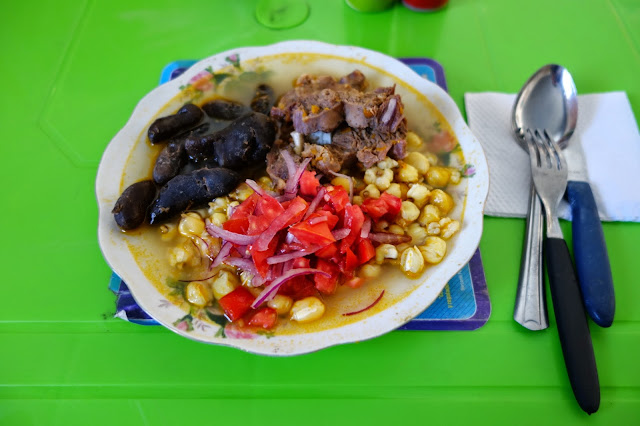The Salar de Uyuni in southwest Bolivia is the world's largest salt flat, covering an area of 10582 sq km and lying an altitude of 3656 m above sealevel. Now I had my chance to ride across it - something I'd been looking forward to since the start of my journey. I set off at dawn from the village of Colchani on the eastern side of the salar. My target was the cactus-covered "island" of Incahuasi 70 km to the west. Before long, I was completely alone on a vast expanse of glaring whiteness that stretched to the horizon in every direction. When I was moving, the only sound was the regular crunch, crunch of my tires as they ran over the mesh of salty ridges left on the surface of the salar by evaporating water. When I stopped, the silence was total.
With no visual markers to judge distance or scale, the ride to the island seemed to take forever. Over time the speck on the horizon slowly grew larger until finally I reached my destination. I met another cyclist on the island who, by pure coincidence, happened to live in my home town of Hamilton in New Zealand. Tori had started his trip in Canada and was riding south towards Patagonia. Meeting him was serendipitous - someone to chat with and someone to help with taking a few funny perspective photos on the salar.
After a peaceful but freezing cold night camping on the salt flat, I was greeted with a fantastic sunrise the next morning. I ate breakfast and warmed up in the sun and contemplated the surreal landscape. I started riding towards Volcan Tunupa on the northern edge of the salar and from there up to the town of Challapata. Along the way, pavement returned, which meant more traffic, well-stocked shops, wifi....I was back to civilisation and, of course, a lot closer to the end of my cycling journey in Sucre.
Leaving Chapallata behind, I followed the Panamericana eastwards for about 200 km to Potosi. It is a tough but scenic ride as the flat altiplano gives way to a more rugged and mountainous landscape dotted with isolated little farming communities.
Potosi sits at 4090 m above sea-level, which makes it the world's second-highest city (after El Alto, also in Bolivia). At one point in history, it was also the world's wealthiest city, thanks to the vast quantities of silver mined from neighbouring Cerro Rico. Potosi is a fascinating place with a storied past, but so keen was I to get to Sucre and start Spanish lessons that I only spent one night there. Fortunately it is only 3 hours by bus from Sucre and I intend to return soon for a longer visit.
Here's a nice quote my cycling buddy Cherry, who in turn took inspiration from the famous Chinese philosopher Laozi: "Every bike tour of a thousand miles ends with a single turn of the pedals". And so it was on 19 May. About 6000 cycled kilometers and 127 days after setting out from Villarica in Chile, I finally reached Sucre in Bolivia and the end of my bicycle trip. It's sweet to have "arrived" and to have completed what I set out to achieve. The last 4 months have been a great adventure and now I'm quite happy to be settled in one place for a while. I'm attending Spanish classes here in Sucre and staying with a Bolivian host family. It's all a new experience for me and I'm enjoying it so far.
I set for Incahuasi at dawn to avoid headwinds. The island is not yet visible, just the cone of Volcan Tunupa.
Downtown Sucre with its consistent white architecture from the Spanish colonial era is compact and easily explored on foot. The city's name actually has nothing to do with sugar, except in French ;-)
The Plaza de 25 de Mayo in Sucre. Here on 25 May 1809 began the uprising which eventually led to the independence of all of the Spanish Empire's South American possessions. Today, the day is commemorated by a public holiday and street celebrations.
The clocktower of the Metropolitan Cathedral in Sucre. Completed in 1712, it is a symbol of the city.
As part of the 25 de Mayo celebrations, free shows have been running. This is a folkdance group from Colombia.
Los Masis are a folk music group from Sucre. I was pretty surprised to see this poster in their office advertising a performance in Switzerland - from 1977!






































